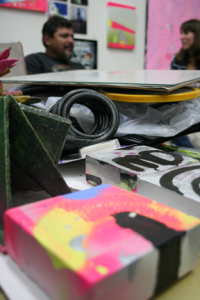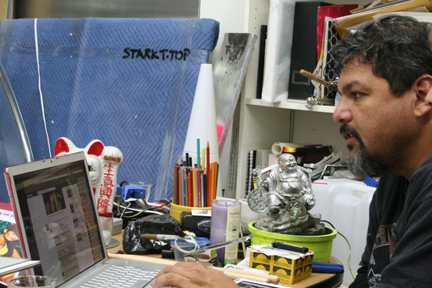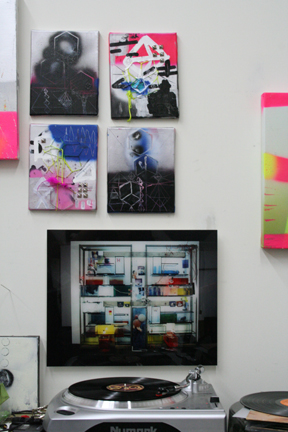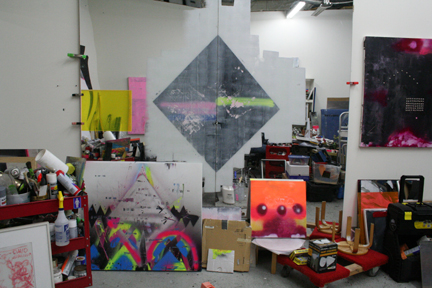Martin Durazo, a Los Angeles based artist and 2012 COLA Fellowship recipient, is one of many contemporary artists in the sprawling L.A. art community whose work stands out among the crowds. His work is instantly attractive -- it's audacious and at times flashy yet always loaded with complex symbolism and stratified references. Out of a desire to connect with other artists and see what is happening in this expansive art scene, I have been visiting artist studios and documenting our conversations. I recently sat down with Durazo at his studio and asked him to talk to me about his current work which spans the mediums of painting, sculpture and installation and (at times) has interactive aspects in which the viewer can literally enter.

Martin Durazo: It's an ongoing body of work called "Plata O Plomo", which is a euphemism that drug traffickers use, which translates from Spanish to English as "silver or lead". It's the principle of offering somebody a bribe (which would be the silver) or the lead (which would be filling them with bullets, or killing them). I've been very interested in this thing called the "aesthetic of the illicit", or the idea that in our society, all things illicit seem to be coded or identified through a very specific color palette, or by certain colors. Whether it is the colors associated with all things related to the environment of drug trafficking or consumption or things to do with what one would call social subcultures, that is the color palette that I am drawing from for this body of work.
Virginia Broersma: So your interest in it is more conceptual versus coming from your personal experience, although you're probably impacted somewhat by being in Southern California, right?
MD: Yeah, I would say that it has to do with things that I'm drawn to, but again, that aesthetic rather than just the idea of the consumption of things that are necessarily bad for you. It's more of an interest to me as to why we are attracted to them; what is it that really attracts us to them? Is it just a feeling or is there an aesthetic that creates that feeling? And that's what I'm interested in finding and exploring in terms of a visual artist.
VB: So how does that translate into your work?
MD: Well the Plata O Plomo is kind of self-explanatory. I did a body of work that the color theme is either this metallic silver or more like a dead color scheme, which then moved into these bright colors that used to be part of, I would say, the Mexican landscape for bars and nightclubs that would rely heavily paint colors that were electrified from black light. And then the idea is to put it all together in either a two-dimensional or three-dimensional situation and see what they look like in the light of day. So again, it becomes like a third level or a tertiary presentation of what it started out with.

VB: What's the most challenging part of the process for you?
MD: Wow, um... seeing it.
VB: Do you mean once the work is finished?
MD: No. Even from the beginning I started to see it, started to see things that made sense to me and then translated it into the imagery that would then become the artwork. In one way or another I've been working on this body of work for almost three years now. In that time I've done 2.5 solo shows/projects that explored this idea and now I see myself becoming more interested in, I hate to use the word, the spiritual side of encountering things that are illicit or are pushing the boundaries of one's mortality, and what does that then look like?  I think that's the direction of the work. It's becoming more ethereal, more spacey. I'm gravitating towards imagery that has to do with some kind of spiritual geometry, like images of pyramids or inverted pyramids that look like diamonds. Now I'm getting into a hexagon shape with has to do with this weird kind of mathematical spiritual.
I think that's the direction of the work. It's becoming more ethereal, more spacey. I'm gravitating towards imagery that has to do with some kind of spiritual geometry, like images of pyramids or inverted pyramids that look like diamonds. Now I'm getting into a hexagon shape with has to do with this weird kind of mathematical spiritual.
VB: You had something in your installation at Barnsdall that looked like an Aztec or Mayan pyramid? Is that related?
MD: Yeah, again all those pyramids are broken down to something that's very mathematical like those step style pyramids that pre-Colombian cultures were into. I can't help but be interested in it because I found there's this connection for me as to why, let's say, narco-drug traffickers have become increasingly violent insomuch as there is a ceremonial approach to the violence and the horror. In Mayan culture there's the history of bloodletting and human sacrifice -- and in a very gory way -- of pulling somebody's heart out their chest while they're still alive. So I started to draw that parallel and that's why you start to see these images and a little bit more literal in that last show with the COLA fellowship where I had that pyramid.
VB: What's the most exciting part of the process for you? Is it the initial idea or...
MD: Sure, the research, (laughs) you know? It's fun for me. I like to explore why people are attracted to these things. It doesn't mean that I participate in all things illicit, but these things are of interest me. As artists I think we're here to observe and interpret and so that's where I'm coming from with this work. Although there's naughty stuff that I do (laughs) that sprinkles a little flavor on it.
Martin Durazo's work can be seen online at www.luisdejesus.com and www.martindurazo.com.